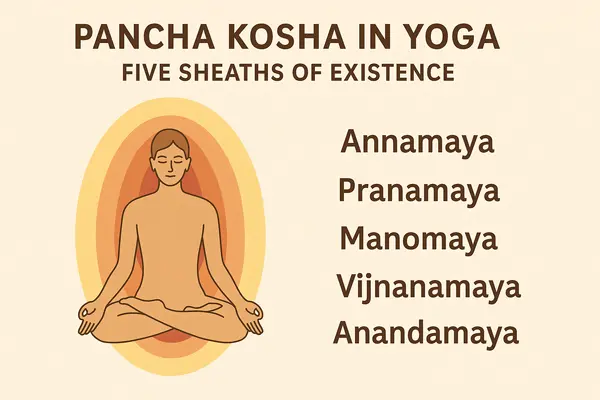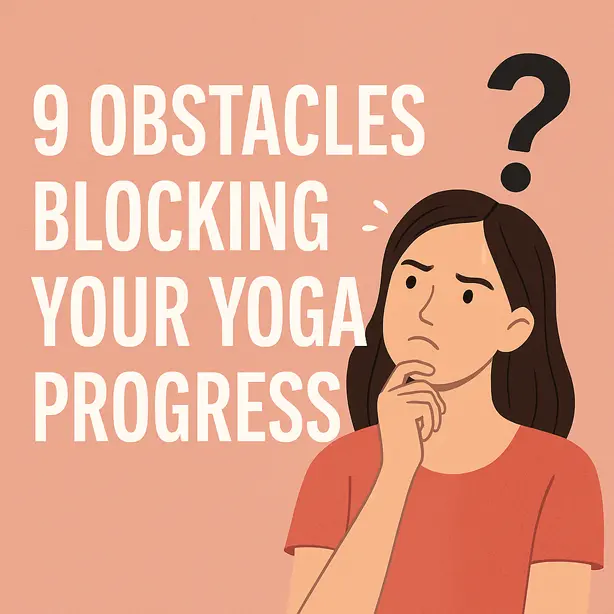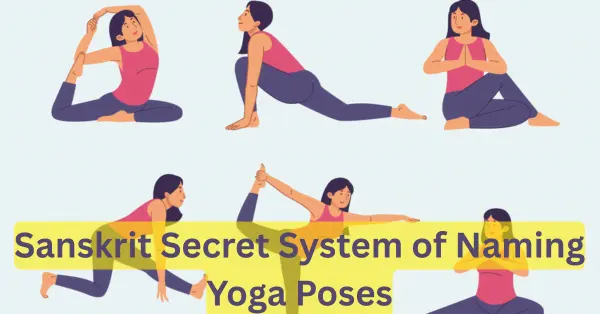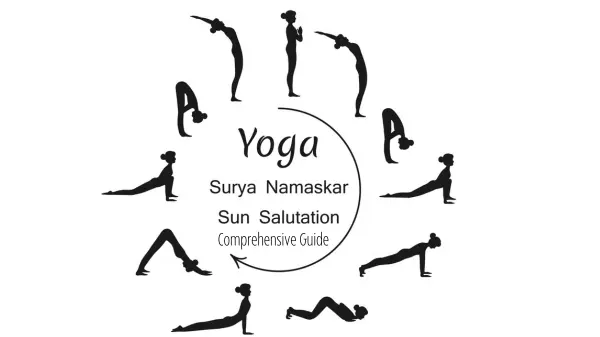Mudra is like a circuit of energy. Depending on the body’s position, we make a deliberate closed circuit of a certain type of energy in the body.
The Sanskrit word Mudra (Mud+Dra) is a combination of two words. Mud means Delight or Bliss, and Dra means to dissolve. Hence, something that helps you dissolve and experience bliss is known as Mudra.
Whenever you practice Mudras, you try to go beyond the physical aspect of your existence. In yogic terms, you transcend the layers of the body, going from Paranamaya Kosha to the Anandmaya Kosha.
The principle of mudras is that the transfer of energy takes place from a higher level to a lower level.[1]
5 Types of Mudras in Yoga
1. Hastha Mudras
Hand Mudras, as the name suggests, uses hands. For example, Chinamaya Mudra, Gyan Mudra, Adi Mudra, and so on.
2. Mana Mudras
You use your mind to make Mana Mudras. For example, Shambhavi Mudra, Shanmukhi Mudra, Nasagra Mudra, and so on.
3. Kaya Mudras
Kaya or postural mudras use your entire body. For example, Vipreeta Karani Mudra, Tadagi Mudra, or Yoga Mudrasana, and so on.
4. Mudras and Bandhas
In this, you combine Bandhas (Internal body locks) with different Mudras. For example, Maha Mudra, Maha Bheda Mudra, Maha Vedha Mudra, and so on.
5. Adhara Mudras
Adhara Mudras use the perineal muscles. For example, Ashwini Mudra, Sahajoli Mudra, Virjoli Mudra, and so on.
Mudras of the 5 Elements
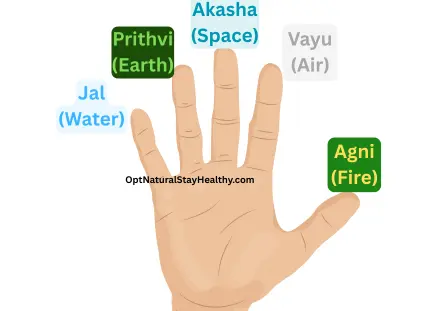
Mudras with Earth, Fire, Water, Ether, and Air elements. Mudras of Elements come under the Hasta mudras or the Mudras of hands.
Yoga mudras are specific hand gestures that are believed to channel the body’s energy and promote physical and mental well-being.[2]
How to Utilise the Mudras using palms
Mudras are hand gestures used in yoga and Ayurveda to balance the five elements (air, fire, water, earth, ether) in the body. Each finger represents an element, and specific finger-thumb combinations can increase, decrease, or balance these elements, influencing physical and mental health.
General Principles
- To decrease an element: Bring the tip of the finger representing that element to the base of the thumb and press gently.
- To balance an element: Touch the tip of that finger to the tip of the thumb.
- To increase an element: Touch the base of the finger with the thumb.
Use both palms for Hasta Mudras (hand mudras) for optimal effect.
How to Practice
- Sit comfortably (e.g., lotus pose, half lotus, or thunderbolt).
- Place hands on your thighs, palms facing up.
- Hold each mudra for up to 15 minutes per session, up to three times a day (total 45 minutes per mudra daily).
- Maintain a gap of 1.5–2 hours after meals before practising; for heavier meals, a 3–4 hour gap is advisable.
- Always consult a healthcare provider before starting if you have medical conditions.
Key Mudras and Their Benefits
Hand Reflexology & Mudras
Hand reflexology works on the principle that specific points on the palms correspond to organs and systems in the body. Mudras, by stimulating these points, can influence overall health and energy flow. For example, the thumb tip is linked to the pituitary gland, so certain mudras may stimulate hormonal balance and well-being.
Cautions
- Duration: Do not exceed 45 minutes per mudra per day.
- Medical supervision: Consult a doctor before starting, especially if you have health issues or are on medication.
- Consistency: Regular practice is key for noticeable benefits.
By practising these mudras with awareness and proper technique, you can support your physical and mental well-being by balancing the body’s elemental energies and stimulating reflex zones in the hands
How to Practice Mudras
Practising Mudras is simple yet powerful. Here’s a step-by-step guide to help you integrate them into your daily routine effectively:
✅ 1. Choose the Right Mudra
Select a mudra based on your specific need — whether it’s for improving digestion, calming the mind, enhancing focus, or balancing the doshas.
✅ 2. Sit in a Comfortable Posture
Sit in Sukhasana (Easy Pose), Padmasana (Lotus Pose), or even on a chair with your spine straight and shoulders relaxed. Keep your eyes gently closed.
✅ 3. Use Both Hands
Most Hasta Mudras (hand gestures) are practised using both hands simultaneously for optimal energy flow.
✅ 4. Hold the Mudra Gently
Do not press the fingers forcefully. The touch should be light and natural, maintaining a sense of ease.
✅ 5. Breathe Deeply and Mindfully
Focus on your breath. Inhale and exhale slowly through the nose, allowing your mind to settle and your body to relax.
✅ 6. Duration of Practice
- Start with 5–15 minutes per session
- Can be practised up to 3 times a day
- Maximum total: 45 minutes per day
✅ 7. Best Time to Practice
Early morning is ideal, but mudras can be practised any time — just make sure to wait 1.5 to 2 hours after meals.
✅ 8. Combine with Meditation or Pranayama
For deeper benefits, practice mudras alongside meditation, deep breathing, or chanting mantras.
✅ 9. Stay Consistent
Like yoga and meditation, consistency is key. Practising regularly enhances the effect of the mudra over time.
⚠️ Note:
If you have a medical condition, consult your doctor before practising therapeutic mudras regularly.
Benefits of Mudra
- Enhance neural activity and brain function: Mudras can improve neural connectivity, supporting better brain health and cognitive performance.
- Regulate breathing and reduce stress: Practicing mudras helps calm the nervous system, regulate breath, and lower stress and anxiety levels.
- Improve focus, mindfulness, and emotional well-being: Regular practice enhances concentration, emotional stability, and overall mindfulness, making it easier to manage negative emotions and improve mood.
- Support physical health: Specific mudras can aid in managing health conditions such as obesity, high cholesterol, hypothyroidism, chronic fatigue, osteoarthritis, and even minor ailments like headaches and digestive issues.
- Boost energy and vitality: Mudras help balance the flow of energy (prana) in the body, increasing vitality and reducing fatigue.
- Link brain and body: These gestures act as catalysts, stimulating endorphin release, soothing pain, and improving overall body functions.
- Promote inner peace and spiritual growth: Some mudras, especially when combined with meditation, can deepen self-awareness, promote inner peace, and facilitate spiritual development.
How do Mudras Work
Mudras work by arranging the fingers and hands in specific positions that influence the flow of energy (prana) within the body. According to yogic and Ayurvedic science, each finger represents one of the five elements—fire, air, space, earth, and water. When you form a mudra, you create an “energy circuit,” allowing prana to flow in a particular way, which helps balance these elements and restore harmony in the body and mind.
Key mechanisms by which mudras work include:
- Energy Circuit Completion: Touching fingertips together or pressing fingers into the palm closes an energy circuit, similar to completing an electrical circuit, allowing energy to flow and be redirected throughout the body.
- Balancing Elements: By stimulating specific fingers, mudras help balance the corresponding elements, which can correct imbalances that manifest as physical or mental health issues.
- Stimulation of Nerves and Brain: The hands are densely connected to the brain. Forming mudras stimulates nerve endings and reflex zones in the fingers, sending signals to the brain that can influence mood, consciousness, and even organ function.
- Physiological Effects: Mudras can improve blood circulation, regulate blood pressure, enhance organ function, and stimulate the nervous system. For example, certain mudras are known to lower blood pressure or boost metabolism by influencing internal energy flow.
- Psychological and Emotional Impact: Regular practice of mudras can calm the mind, improve concentration, and support emotional stability by affecting neural pathways and brain activity.
- Catalyst for Healing: Mudras act as catalysts, helping to link the brain and body, soothe pain, stimulate endorphin release, and increase vitality.
By integrating mudras into daily practice, you can tap into the body’s innate ability to self-regulate, heal, and achieve greater physical, mental, and spiritual well-being.
Conclusion
In conclusion, mudras are powerful, accessible tools that can significantly enhance physical, mental, and spiritual well-being. By harnessing the connection between the hands, body, and mind, regular practice of mudras can help balance the body’s energy, reduce stress, improve concentration, and support emotional stability.
They also offer therapeutic benefits for various health conditions and serve as valuable complements to meditation and yoga practices. As both ancient wisdom and modern research suggest, incorporating mudras into daily life can promote greater harmony, vitality, and holistic health.
Mudras aid in the balance of the human body’s five elements, with each finger representing one of the five elements: fire, air, space, earth, and water.[3]
Reference
[1] Sunitha S, Sharma CP. Mudra Therapy and Its Classification. Int J Health Sci Res. 2021 Jan;11(1):118-125. Available from: Link to Study. <Go to Citation>
[2] Vandali V, Biradar RB. Yoga Mudras: Benefits. Int J Adv Nurs Manag. 2018;6(4):324-328. Available from: Link to Study. <Go to Citation>
[3] Abarna S, Rathikarani V, Dhanalakshmi P. SIFT and SURF features based classification of yoga hand mudras using machine learning techniques. Int J Health Sci. 2022;6(S1):1971-1984. Available from: Link to Study. <Go to Citation>


